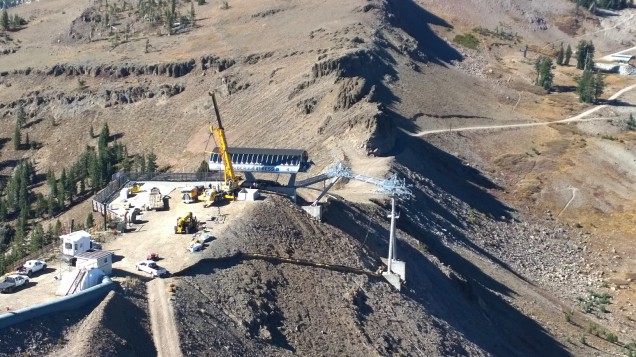Squaw Valley has removed ten of its lifts since 2007 while building only four new lifts in the same period. What’s going on? Squaw is strategically removing redundant/older fixed grips like Cornice II and replacing first-generation detachable quads with newer technology. This summer’s project replaces the Siberia Express (a 1985 Poma) with an all-new Leitner-Poma six-pack. The new Siberia will be Squaw’s second lift with LPA grips and terminals. The first was the Big Blue six-pack, which replaced not one but three Yan lifts in 2012. The LPA grip is now used worldwide by both Leitner and Poma but terminals used in North America are designed and built in Grand Junction, Colorado.
The original Siberia was a workhorse at Squaw for thirty years, operating in a harsh above-treeline environment. It had an old-school Alpha drive building and chain-driven contours. In addition to upgraded technology, the new Siberia should be less subject to wind closures with heavier chairs. In a press release announcing the project, Squaw Valley CEO Andy Wirth noted, “upgrading the Siberia Express lift to a high-speed six-passenger chairlift is guaranteed to have a positive impact on the skier experience on the upper mountain at Squaw. In addition, the lift has been designed in a way that will improve its ability to operate during inclement weather.” Because its line is so exposed, the new lift has parking for all 56 chairs at the drive terminal.

The old Siberia had a unique double portal tower downhill of the top terminal that crews brought crashing down in a snowstorm last June. Not to fear, however, as the new lift has an even cooler double tripod tower connected to the top terminal with a catwalk. Leitner-Poma engineer Justin Gross explained to me how it came to be as a result of wanting to re-use old foundations. “There was enough there to easily handle the new loads, so it saved a lot of work constructing new footings off the edge of that ‘cliff.’ We also knew where the cross arms needed to be for adequate break over and clearance. The design of the tower was primarily dictated by connecting the two in each location. The catwalks actually provide a structural connection and tie everything back to the main terminal foundation.” Pretty cool and it keeps Siberia’s unique character as a bonus.

Here’s a rundown of the stats on the new bottom drive, clockwise-rotation Siberia. It has 14 towers with 170 sheaves between them. Slope length is 3,847 feet with a vertical rise of 923 feet, almost identical to the previous quad. Moving at 1,000 feet a minute, the six pack will transport 2,400 skiers per hour with a ride time of just 3.8 minutes. Chair interval is a comfortable 9 seconds with 150′ spacing. Siberia will have a 500 horsepower AC drive motor with two 300 horsepower auxiliary drives, one of which can serve as the evacuation drive.



Both of Siberia’s new terminals and all 14 towers are in place with Squaw’s opening day set for November 26th. Many more big lift projects are in the pipeline at Squaw Valley and Alpine Meadows with detachable replacements for Hot Wheels and Granite Chief already approved and the Base-to-Base Gondola on the horizon.


I helped in the final construction of the Original Siberia Express, back in the fall of 1985. Helped piece together the chairs and safety bars. Ended up on the crew that ran the lift for the first two seasons.
The original had no chair storage the first two years and a very limited APU which ran at 1 meter/second for clearing the line when power failed. The chain driven contours were a major headache as occasional spacing had to be done manually with a crew of 6 or 7 assisting. There was space for six or seven chairs to be off-line and this was often done when overnight weather/icing was possible. I believe the gap that the chair removal created was placed at the top terminal to protect the sheave trains and inner top terminal mechanics from problems.
The entire lift was French-built (note: the Poma factory people left an obscene message to Squaw Valley on the inside of one of the top panels) and all the Poma employees were French.
It was a loud lift that one could hear from a distance when running 5 meters/second. It did quickly empty a lift line, being so popular and new.
At 5 meters/second, load time, at the bottom terminal, was approx. 4.5 seconds per chair… Lift operators had to keep people aware and watch for their antics. There were only safety bars on the chair… no foot rests.
Originally Squaw upper management had put on sheaves, durometer rated at 4 meters/second, and yet told the crew that we were allowed, after the first month, to run 5 meters/second when necessary. I watched a sheave liner disintegrate from the rapid speed/added friction/pressure and had to tell the bottom terminal to close the lift and run the line off at 3 meters/second while Squaw’s lift maintenance was checking the line and getting replacement sheaves for the problem. The lift was shut down for several hours but showed the Squaw management team that new sheaves liners were necessary (they were replaced before the second season started).
Sorry this is so long but I have been following your blog for a time but totally missed your articles regarding detachable quads and aging.
In 1987 I assisted with Squaw’s Shirley Lake Express Poma Detachable Quad also. Totally different than the Siberia Express (American built). I also assisted on Bear Mountain’s (Southern California) Garaventa/CTEC detachable in 1990 as well.
Feel free to contact me if you have any questions.
Thanks, John Janecek
LikeLiked by 1 person